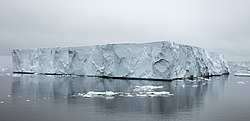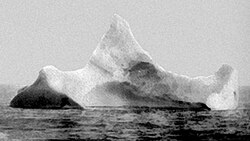Iceberg
An iceberg is a large piece of ice floating in the sea.[1] It is generally found in cold water near the North or the South Pole. Icebergs are especially common during spring when ice has begun to melt.
About 90% of icebergs are below the water line. Icebergs break off from larger structures made of ice like glaciers or ice shelves. They are formed by snowfall in very cold places that it do not melt in the summer. The snow builds up and compacts into ice, which is gradually pulled downhill by gravity and into the sea. The ice then falls off and makes icebergs, which can drift in the sea for years before they have melted completely.
History
The first person to give a correct scientific explanation of this phenomenon was Mikhail Lomonosov, who did so around 1750. He grew up on the shore of the White Sea in the European part of Russia. He studied in Marburg, Germany, and is credited with introducing the word iceberg into Russian.
The density of ice is about 0.92 kg per liter, and that of sea water is about 1.025 kg per liter, which causes 920 parts of the 1025, or about 90 percent, of the iceberg's volume to be below the water line.
Icebergs are very dangerous to ships, and many ships have sunk after crashing into icebergs. The most famous case was RMS Titanic in 1912.
Largest iceberg
D15A is the largest iceberg, as of the third quarter of 2025.[2]
A23a used to be the largest iceberg.[3]
Earlier, the largest iceberg that people know about was B-15. It broke off the Antarctic ice sheet in 2000 and was as large as the island of Jamaica (over 10,000 km2). The iceberg soon started to break up into smaller pieces, some of which remained in 2008.
Icebergs have become large because of global warming.
Colors
Iceberg Media
An iceberg in the Arctic Ocean
Northern edge of Iceberg B-15A in the Ross Sea, Antarctica, 29 January 2001
Grotto in an iceberg, photographed during the British Antarctic Expedition of 1911–1913, 5 Jan 1911
Tabular iceberg, near Brown Bluff in the Antarctic Sound off Tabarin Peninsula
The iceberg suspected of sinking the RMS Titanic; a smudge of red paint much like the Titanic's red hull stripe runs along its base at the waterline.
An iceberg being pushed by three U.S. Navy ships in McMurdo Sound, Antarctica
Acoustic monitoring of an iceberg
References
- ↑ "Common Misconceptions about Icebergs and Glaciers — Icebergs and Glaciers — Beyond Penguins and Polar Bears". Retrieved 2020-08-16.
- ↑ https://www.vg.no/nyheter/i/LM2p0Q/verdens-stoerste-isfjell-bryter-opp-etter-40-aar. Retrieved 2025-09-05
- ↑ https://www.livescience.com/planet-earth/antarctica/40-year-old-queen-of-icebergs-a23a-is-no-longer-worlds-biggest-after-losing-several-very-large-chunks-since-may. Retrieved 2025-09-05










